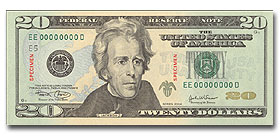NEW YORK (CNN/Money) -
It's party time for the nation's moneymakers: the redesigned $20 bills are reaching the public.
About $19 billion worth of the new notes went into circulation Thursday -- some 20 percent of the total value of all $20 bills. Armored trucks started delivering them from Federal Reserve vaults to commercial banks across the country.

| |
|
Old Hickory gets a makeover. Click on it for detail.
|
|
Meanwhile, the Fed and its Bureau of Engraving and Printing (BEP) will hold a nationwide series of publicity events, part of a $33 million campaign to let the world know the new bills are legit.
"The goal is public education, to build awareness and trust," said Dawn Haley, a spokeswoman for the Bureau of Engraving and Printing (BEP).
Government administrators, politicos, and various bigwigs will be among those rushing to spend the first batch of bills on Oct. 9.
| Related Stories
|

|
|
|
|
BEP Director Tom Ferguson is unveiling a billboard in Times Square. Other officials will be at Washington's L'Enfant Plaza, and the Hermitage in Nashville.
Some hot new money will go for fresh hot coffee. In New Orleans, Fed folks will buy beignets and chicory java at the Cafe du Monde on Jackson Square. In San Francisco, Peet's Coffee is the destination of choice; in Seattle, it's a Starbucks.
If you want one
The government intends "to flood the system" to get the twenties circulating, one official said. That doesn't mean you'll start seeing the bills widely on the first day. Releasing the bills to commercial banks is just the first step.
For starters, a bank needs to request currency deliveries before it can replace old bills with new ones. This doesn't necessarily happen every day -- depending on a particular bank's inventory depletion, it may be days or weeks before it needs to re-order.

"They'll be available in many locations starting on the 9th," says Ashleigh Adams of the Bank of America, which has 4,300 branches in 23 states. "But more than likely, they won't be everywhere until after Columbus Day."
ATMs generally won't have them, either. Banks often prefer to put older notes in the machines, since using brand-new bills involves a re-calibration process. If you really want to get your hands on new cash, you may have to see a teller.
If you live in a remote location, it may also be some time before you see the bills. Banks closest to Federal Reserve facilities will get them first. As those banks pass the twenties along to customers, who then spend them, the trickle-down process begins.
Promotional campaign
Even if you don't see an actual note this week, it may be difficult to miss the commotion associated with the launch. The government has hired Burson-Marsteller to oversee the marketing campaign, and retained Hollywood firms Davie-Brown and William Morris.
The BEP has sent out more than 37 million pieces of instructional information to businesses and organizations, in an attempt to teach merchants how to identify authentic new bills. There is also an elaborate Web presence at www.moneyfactory.com.
The effort includes about $12 million of paid advertising, plus quite a bit of product placement.
| 
| |

| 
| 
|

|
 CNNfn's Ali Velshi reports from the Bureau of Engraving and Printing on the new and more colorful $20 bill. CNNfn's Ali Velshi reports from the Bureau of Engraving and Printing on the new and more colorful $20 bill.
|
 Play video
Play video
(Real or Windows Media)
|
| 
|

|
|
The twenties are being featured on game shows, including "Wheel of Fortune" and "Jeopardy," and sporting events, like ESPN's college football telecasts.
Late-night comics have made jokes about it. (David Letterman's take: the redesign looks like a "Queer Eye for the Straight Guy" makeover.)
The bills are also part of some consumer product tie-ins. For example, pictures of them will be on the side of bags of Pepperidge Farm Goldfish, a unit of Campbell Soup (CPB: Research, Estimates).
Stopping the bad guys
The redesign is driven primarily by a desire to stem counterfeiting. "These are the most secure notes the U.S. government has ever produced," said Fed governor Mark W. Olson last month.
Only 1 bill in 10,000 is illegitimate, according to the Secret Service, but widespread access to digital printing technology has made counterfeiting easier. "Amateur" counterfeiters distributed a reported $15 million in fake cash last year, more than five times more than a decade ago.
Professionals made a lot more. The U.S. government seized about $130 million in (unused) counterfeit notes last year, according to the Secret Service. Almost $44 million more was retrieved from circulation. Nearly 5,000 people involved were arrested.
Among the safety features of the new bills are a watermark image engrained into the paper itself; an embedded vertical plastic strip; and color-shifting ink, whose appearance changes from copper to green as the bill is tilted against light.
Of course, the most obvious change is that the greenback now features colors like blue and a pinkish-orange hue that the government calls "peach."
It is the first time in almost 100 years that a mass-circulation U.S. note has prominently contained a color besides green and black.

|

